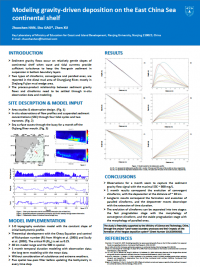CSDMS 2015 annual meeting poster ZhuochenHan
Modeling gravity-driven deposition on the East China Sea continental shelf
Shu Gao, Nanjing University, NanJing, China.
Abstract:
Sediment gravity flows in relation to the clinoform formation associated with the Changjiang distal mud deposit on the inner shelf off the Zhejiang-Fujian coast, the East China Sea, are investigated using a process modeling approach. Different from the classic turbidity current and hyperpycnal flow theories, which rely on auto-suspension and high sediment load from rivers, respectively, the type of the gravity-driven, down-slope sediment transport in consideration is the movement of bottom turbid layers resulting from resuspension induced by tidal currents and waves. Compared with rapid down-slope movements of turbidity currents with a high sediment transport rate, the bottom turbid layer represents a small scale event; during such an event, only a short distance is covered by sediment movement. However, the cumulative effect of such frequent, short scale may produce large scale clinoforms, in response to repeated action of the bottom turbid layer. In our numerical experiments, both wave- and tidally-induced resuspension events are simulated; the critical Richardson number plays the key role in controlling the gravity-driven transport load. The results suggest that the modeled resuspension pattern is consistent with the in-situ observations undertaken in March 2014, off the Oujiang River mouth in the study area. Likewise, the gravity-driven deposition pattern obtained is supported by the seismic record which reveals parallel clinoforms within the distal mud. The simulation results support the hypothesis that the two types of clinoforms, i.e., convergence and parallel ones, are associated with settling and Bottom turbid layer processes, respectively.
* Please acknowledge the original contributors when you are using this material. If there are any copyright issues, please let us know and we will respond as soon as possible.

